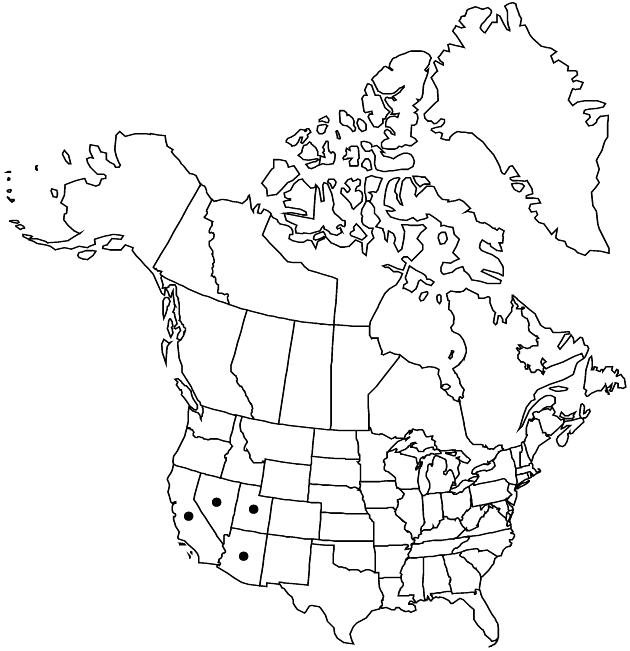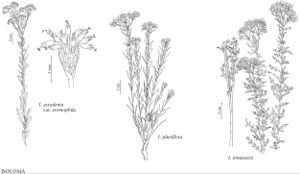Isocoma acradenia var. eremophila
Phytologia 70: 82. 1991.
Illustrated
Basionym: Isocoma eremophila Greene Leafl. Bot. Observ. Crit. 1: 171. 1906
Synonyms: Haplopappus acradenius subsp. eremophilus (Greene) H. M. Hall Isocoma acradenia subsp. eremophila (Greene) R. M. Beauchamp
Revision as of 19:55, 29 July 2020 by imported>Volume Importer
Leaf-blades mostly 2.5–5 cm, margins pinnately toothed to pinnatifid. Involucres 6–8 m. Phyllary apices usually rounded, sometimes with weakly developed aristae. Florets 12–20.2n = 12.
Phenology: Flowering (May–)Aug–Nov.
Habitat: Sandy soils, alkaline or salt flats, desert dunes, often with Saguaro-Prosopis-Larrea, Larrea, Atriplex, Yucca, or mixed shrubs
Elevation: (-15–)0–900(–1100) m
Distribution

Ariz., Calif., Nev., Utah, Mexico (Baja California), Mexico (Sonora)
Discussion
For the most part, var. eremophila is geographically separate from var. acradenia. In southwestern Nevada many intergrades occur; in San Bernadino County, California, the two taxa appear to be contiguous with little or no intergradation. In the latter area, the taxa apparently are at different ploidy levels.
Selected References
None.
Lower Taxa
None.
"thick" is not a number.
... more about "Isocoma acradenia var. eremophila"
introrse +
connate +
green +
distinct +
herbaceous +
scarious +
hirsute +
papillate +
developed +
continuous +
decurrent +
1-nerved +
linear;oblanceolate or obovate +
ribbed +
cluster +
stigmatic +
barbellate +
persistent +
40;50 +
unequal +
absent +
lateral +
smaller +
yellow +
absent +
monomorphic +
5-11-ribbed +
dimorphic +
staminate +
straight +
gland-dotted;gland-dotted +
distinct +
proximal +
12;20 +
bisexual +
dispersed +
Sandy soils, alkaline or salt flats, desert dunes, often with Saguaro-Prosopis-Larrea, Larrea, Atriplex, Yucca, or mixed shrubs +
discoid +
singly +
indeterminate +
resinous +
Present +
surrounding +
obconic;turbinate or campanulate +
sessile +
alternate +
cauline +
erect +
deltate +
scarious +
2-carpellate +
inferior +
attached +
anatropous +
persistent +
tough +
thick +
absent +
connate +
1-nerved +
persistent +
distinct +
falling +
unequal +
rounded +
Phytologia +
1991 +
absent +
sterile +
epaleate +
pitted +
concave;usually flat;conic +
developed +
single +
fibrous +
exalbuminous +
modifed +
2;4;6 +
Illustrated +
alternate +
resinous +
gland-dotted +
erect +
triangular +
2-branched +
glabrous +
Isocoma acradenia var. eremophila +
Isocoma acradenia +
variety +
corymbiform +
goblet--shaped +
ampliate +
longer +
dark orange-resinous +
perennial +
subshrub +
